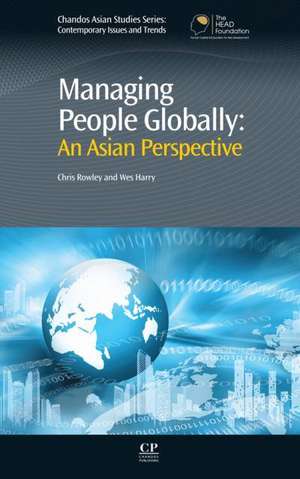Managing People Globally: An Asian Perspective: Chandos Asian Studies
Autor Chris Rowley, Wes Harryen Limba Engleză Hardback – 27 mai 2011
- Considers the influences on HRM, including the political, economic and social contexts and expectations
- Discusses organisational behaviour impacts on HRM
- Review of HRM in Asia with topics and practices organised thematically and integrated, rather than by country
| Toate formatele și edițiile | Preț | Express |
|---|---|---|
| Paperback (1) | 531.06 lei 36-50 zile | |
| ELSEVIER SCIENCE – 21 aug 2016 | 531.06 lei 36-50 zile | |
| Hardback (1) | 611.69 lei 22-36 zile | +26.22 lei 5-11 zile |
| Woodhead Publishing – 27 mai 2011 | 611.69 lei 22-36 zile | +26.22 lei 5-11 zile |
Preț: 611.69 lei
Nou
Puncte Express: 918
Preț estimativ în valută:
117.04€ • 122.53$ • 96.85£
117.04€ • 122.53$ • 96.85£
Carte disponibilă
Livrare economică 17-31 martie
Livrare express 28 februarie-06 martie pentru 36.21 lei
Preluare comenzi: 021 569.72.76
Specificații
ISBN-13: 9780857091468
ISBN-10: 0857091468
Pagini: 200
Dimensiuni: 165 x 241 x 25 mm
Greutate: 0.02 kg
Editura: Woodhead Publishing
Colecția Chandos Asian Studies
Seria Chandos Asian Studies
ISBN-10: 0857091468
Pagini: 200
Dimensiuni: 165 x 241 x 25 mm
Greutate: 0.02 kg
Editura: Woodhead Publishing
Colecția Chandos Asian Studies
Seria Chandos Asian Studies
Cuprins
Dedication
List of figures and tables
Acknowledgements
Abbreviations
About the authors
Chapter 1: Introduction: HRM context, development and scope
1.1 Introduction
1.2 Chapter features and the wider relevance of HRM
1.3 What is HRM?
1.4 Rhetoric and reality in HRM
1.5 Tensions in HRM
1.6 A strategic role?
1.7 The context of HRM
1.8 Scope
1.9 Conclusion
Chapter 2: Employee resourcing
2.1 Introduction
2.2 Overview
2.3 HRP
2.4 Activities in HRP
2.5 Methods and data in HRP
2.6 Impacts on HRP
2.7 HRP in practice
2.8 Recruitment and selection
2.9 Stages
2.10 Sources and methods of recruitment and selection
2.11 Selection
2.12 Methods
2.13 Recruitment and selection in practice
2.14 Conclusion
Chapter 3: Employee rewards
3.1 Introduction
3.2 Overview
3.3 Rewards and integration
3.4 Types of reward
3.5 Determinants
3.6 Performance-related rewards
3.7 PRP schemes
3.8 Difficulties with PRP
3.9 Rewards in practice
3.10 Conclusion
Chapter 4: Employee development
4.1 Introduction
4.2 Overview
4.3 Training
4.4 Management development
4.5 Factors shaping provision and effectiveness
4.6 Determining and locating training
4.7 Evaluation
4.8 Training in practice
4.9 International comparisons in training
4.10 Variety in training provision
4.11 Performance appraisal
4.12 Methods and techniques
4.12.4 Ranking
4.13 Potential problems with performance appraisal
4.14 International comparisons in performance appraisal
4.15 Conclusion
Chapter 5: Employee relations
5.1 Introduction
5.2 Overview
5.3 Employee relations
5.4 Concept of a ‘system’
5.5 Strategic choice
5.6 Frames of reference
5.7 Individualism versus collectivism
5.8 Partnership
5.9 The future of employee relations
5.10 Employee involvement
5.11 Forms of employee involvement
5.12 Conclusion
Chapter 6: Conclusion
6.1 Introduction
6.2 Key points
6.3 Comparisons
6.4 The future of HRM
6.5 Conclusion
Contemporary developments
Managing people – as seen in art and culture
Case studies
Index
List of figures and tables
Acknowledgements
Abbreviations
About the authors
Chapter 1: Introduction: HRM context, development and scope
1.1 Introduction
1.2 Chapter features and the wider relevance of HRM
1.3 What is HRM?
1.4 Rhetoric and reality in HRM
1.5 Tensions in HRM
1.6 A strategic role?
1.7 The context of HRM
1.8 Scope
1.9 Conclusion
Chapter 2: Employee resourcing
2.1 Introduction
2.2 Overview
2.3 HRP
2.4 Activities in HRP
2.5 Methods and data in HRP
2.6 Impacts on HRP
2.7 HRP in practice
2.8 Recruitment and selection
2.9 Stages
2.10 Sources and methods of recruitment and selection
2.11 Selection
2.12 Methods
2.13 Recruitment and selection in practice
2.14 Conclusion
Chapter 3: Employee rewards
3.1 Introduction
3.2 Overview
3.3 Rewards and integration
3.4 Types of reward
3.5 Determinants
3.6 Performance-related rewards
3.7 PRP schemes
3.8 Difficulties with PRP
3.9 Rewards in practice
3.10 Conclusion
Chapter 4: Employee development
4.1 Introduction
4.2 Overview
4.3 Training
4.4 Management development
4.5 Factors shaping provision and effectiveness
4.6 Determining and locating training
4.7 Evaluation
4.8 Training in practice
4.9 International comparisons in training
4.10 Variety in training provision
4.11 Performance appraisal
4.12 Methods and techniques
4.12.4 Ranking
4.13 Potential problems with performance appraisal
4.14 International comparisons in performance appraisal
4.15 Conclusion
Chapter 5: Employee relations
5.1 Introduction
5.2 Overview
5.3 Employee relations
5.4 Concept of a ‘system’
5.5 Strategic choice
5.6 Frames of reference
5.7 Individualism versus collectivism
5.8 Partnership
5.9 The future of employee relations
5.10 Employee involvement
5.11 Forms of employee involvement
5.12 Conclusion
Chapter 6: Conclusion
6.1 Introduction
6.2 Key points
6.3 Comparisons
6.4 The future of HRM
6.5 Conclusion
Contemporary developments
Managing people – as seen in art and culture
Case studies
Index
